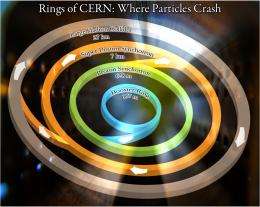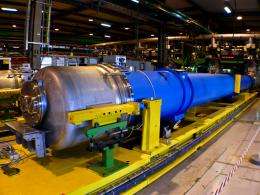Large Hadron Collider powers up to unravel mysteries of nature

Outside the small village of Meyrin, Switzerland, horses graze quietly in fields lined by the Jura mountains. You'd never know it by the idyllic landscape, but 300 feet below the Swiss-French border, the Large Hadron Collider is searching for the secrets of the universe. A 17-mile circular tunnel houses the world’s largest atom smasher that is once again firing high-energy proton beams.
On Monday, the CERN Control Center turned on the LHC beams to begin the next two-year run of the particle collider. CERN directors decided to extend the run through the end of 2012, instead of shutting down in 2011 for repairs as previously planned, and spirits are running high among scientists working in the field of new physics.
Researchers from across the world engineer detectors and seek to solve the mysteries of matter in an international collaboration that reaches from Chicago to Mumbai.
“Recently there was a convention in Chamonix,” said Georgios Choudalakis, a Greek physicist on the ATLAS experiment at the LHC. “The heads of the experiments and the director of the laboratory decided that we will take data for 2 years. And the decisive criterion for this was the sensitivity to the Higgs, so we’re optimistic.”
This comes on the heels of the news that 2011 will be the end of the run for the Tevatron, the second most powerful particle collider in the world located at the Fermi National Laboratory in Batavia. After setbacks and shutdowns, the LHC had collisions in 2010 that went even better than expected. “We made it clear even to ourselves that the page has turned,” said Choudalakis. “The energy frontier is not at the Tevatron anymore. We are cutting more ice here.”
Now, the hunt for the Higgs is on at CERN, the Conseil Européen pour la Recherche Nucléaire.
The elusive Higgs particle is, according to the theory, a fundamental building block of matter and the reason everything has mass.
“Nobody can explain where mass comes from, but we know it’s there,” said Pauline Gagnon, a French physicist at the ATLAS experiment. This conundrum is the most important question physicists have to answer, she said.
“If you think of a one pound bag of salt and you add up the weights of each grain of salt, they will logically equal one pound,” said Gagnon. But, when physicists break down atoms in this way and try to determine the weight of the pieces inside, the calculations of the weight of atomic building blocks such as quarks and electrons don’t add up, she said. Here’s where the Higgs comes in.
The proposed Higgs particle is a part of a field that permeates everything. According to theory, it is a particle’s interaction with the Higgs field that creates drag on a particle, giving it mass. Picture a business man walking through a pool in a suit. The water in the pool is like the Higgs field and, as it soaks into his clothing, it will weigh him down and he will move more slowly. He becomes massive.
Although it has been predicted as the final puzzle piece that completes the Standard Model of physics – the leading explanation for atomic interaction – the existence of the Higgs has never been proven. If such a particle exists, experiments at the LHC should be able to detect it.
“We have indirect suggestions of where it should be if the Higgs exists,” said Choudalakis. “But that is if it exists.” If it can’t be found, the Standard Model will have to be rewritten.
In the next two years, the LHC will resume collisions at 7 TeV, or tera electron volts, between the two beams – the highest energy levels achieved in recent years. The decision at Chamonix mandates that energy in the beams will be kept at this conservative level to avoid the types of machine failures that shut down the LHC in 2008, Gagnon said.
At those energy levels, the two particle beams travel through miles of tubes surrounded by 1,700 superconducting magnets that force bunches of charged particles around the ring and through accelerators designed to increase their speed to within a percentage of the speed of light.
The particle beams, each made up of hundreds of billions of protons, began making their way around a series of underground tubes Monday, guided magnetically and gaining speed and energy. The beams start out about as big around as an index finger and, within microseconds they complete their journey through the four accelerator rings into the LHC and are compressed down to the size of a human hair.
“The beams, at 7 TeV, will have an energy which is the same kinetic energy of a 747 landing, so imagine a big airplane which is landing and smashing against a wall – this is the energy of the LHC beams,” said Mirko Pojer, an Italian and the engineer in charge of the CERN Control Center.

The two beams, moving in opposite directions, collide at 4 points along the ring where the separate LHC experiments house their detectors, which gather data to analyze the collisions that occur every 25 nanoseconds.
Two of the experiments at CERN are designed to detect a possible Higgs particle. Though they have the same goal, the ATLAS and CMS detectors are designed to look at particle collisions differently.
ATLAS, the larger of the two detectors, stands 82 feet high and houses an enormous magnet system that bends the paths of charged particles after collisions in order to measure their momentum, which identifies them.
CMS, the Compact Muon Solenoid, as its name suggests, is more compact than ATLAS. The CMS detector is designed around a large coiled magnet, which creates a uniform magnetic field that is 100,000 stronger than the Earth’s. CMS measures the subatomic debris of the collisions, hunting for signs of the Higgs.
The 3,000 scientists at ATLAS and the 2,000 scientists at CMS are in a race to be the first to make the biggest scientific discovery of the century.
The next two years of operation will provide enough particle collisions for a groundbreaking discovery. If the Higgs exists, the physicists at CMS or ATLAS will see evidence of the particle. With the amount of data that the LHC will be able to gather in the next two years, scientists expect to confirm the existence or absence of the Higgs, said Gigi Rolandi, an Italian and the physics coordinator for the CMS.
These detectors are truly wonders of the modern age. Like the Acropolis or the Great Wall of China, the LHC is just as incredible a feat of engineering, though it cannot be seen as readily. “It’s a real pity that these detectors are underground,” said Choudalakis. “If they were on the surface, everybody would be very proud of what mankind has done.”
At CERN, the discovery of the fundamental building blocks of nature are just around the corner. “People are thrilled by this, and well deservedly,” said Choudalakis. “What is beautiful about science, especially on a big scale like this, is that it makes you feel like you have a little chance in your life, from your humble starting point, to touch your finger on history and leave a fingerprint on it. Imagine history as a big piece of glass. Most people don’t even get close, and you have a chance to leave your fingerprint on it. I think it’s one of the noblest missions a person can have.”
While the discovery of the Higgs would indeed be a milestone for the world of physics, and a tidy completion of the Standard Model, sometimes messy is far more interesting.
“Like we say, if we do not discover the Higgs particle, it will be even more interesting to find out what else is there in the physics and in nature which then controls the amplitudes of interactions of the particles,” said Slawomir Tkaczyk, a Polish physicist on the CMS experiment. “So, after 10 or 15 years of hard work, the most exciting times are still ahead of us.”
This story is republished courtesy of Medill Reports. Medill Reports is written and produced by graduate journalism students at Northwestern University's Medill school.
Source: Medill Reports


















